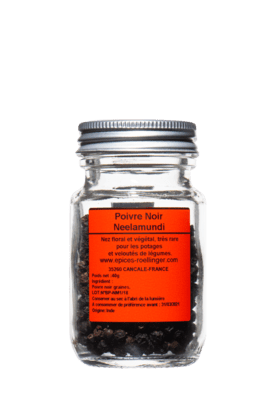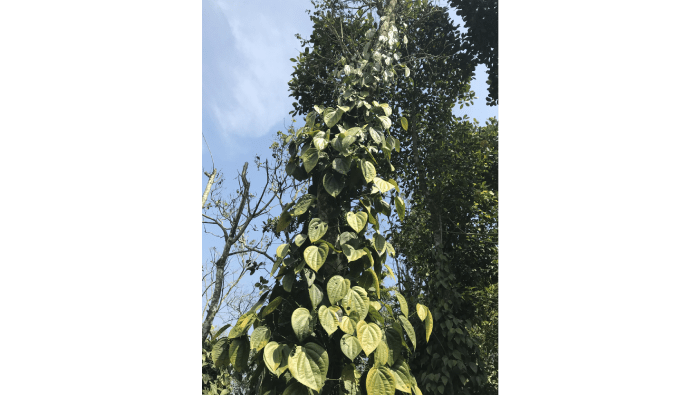Neelamundi Black Pepper

Ingredients: Neelamundi Black Pepper
An extremely rare pepper with floral and vegetal fragrance notes. Use to season vegetables and cream soups.
Rare spices
€6.50
40 g
Perfume
An elegant and lightly tanguy pepper with floral notes and hints of eucalyptus and lime.
-
Allergens
Absent, except for cross-contamination.
May contain traces of sesame, celery, mustard, soy. - Origin Inde
- Storage / Use In a cool, dark, dry place
€162.50 / kg
Olivier Rœllinger's words
Neelamundi pepper's spring flower fragrance is nothing short of astonishing. I am still so happy that 15 years ago, several pepper growers agreed to replant small Neelamundi pepper plants. These have a high yield, but produce peppercorns with a distinctive flavor.
When the weather warms up, I use this pepper on fresh peas, asparagus, and green salads.
In winter, it is especailly good in soups, cream soups, vegetable purées and sauces.
If I could only take one spice with me on a desert island, I'd choose Indian Neelamundi Black Pepper. All I would need is sea salt to bring the foods I found there to life.
When the weather warms up, I use this pepper on fresh peas, asparagus, and green salads.
In winter, it is especailly good in soups, cream soups, vegetable purées and sauces.
If I could only take one spice with me on a desert island, I'd choose Indian Neelamundi Black Pepper. All I would need is sea salt to bring the foods I found there to life.
Story
Neelamundi pepper is a rare variety from Kerala, India. Only a few kilos are harvested each year. The black peppercorns have blue highlights and Neelamundi means "blue peppercorn" in Malayalam, the local language.
In Kerala, almost 15 years ago, 17 growers agreed to harvest, select, and sort by hand their peppercorn crops according to their botanical variety instead of their size. It was a gamble that went against the grain of previous custom.
We work with sustainable producers who respect the region's biodiversity. All the peppercorns are gathered by hand on small (3-acre) jungle-farms in the middle of the forest where coffee, cocoa beans, cardamom, coconuts, and bananas are also grown.
In Kerala, almost 15 years ago, 17 growers agreed to harvest, select, and sort by hand their peppercorn crops according to their botanical variety instead of their size. It was a gamble that went against the grain of previous custom.
We work with sustainable producers who respect the region's biodiversity. All the peppercorns are gathered by hand on small (3-acre) jungle-farms in the middle of the forest where coffee, cocoa beans, cardamom, coconuts, and bananas are also grown.

